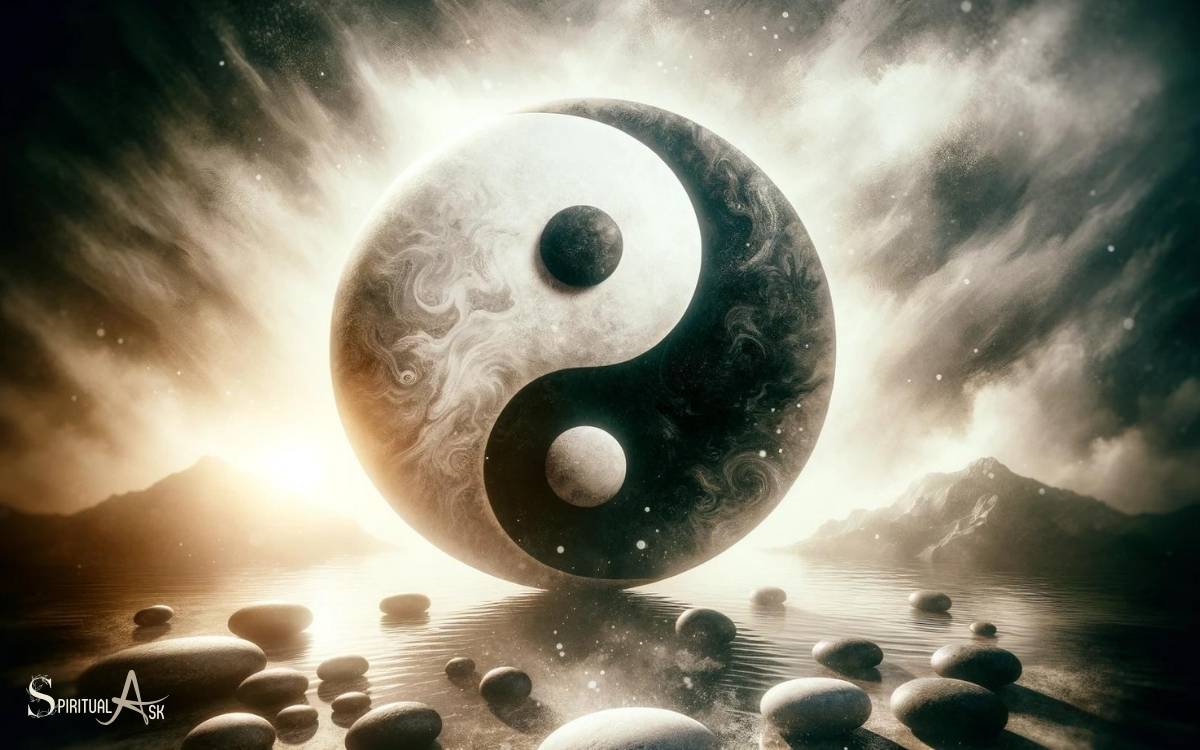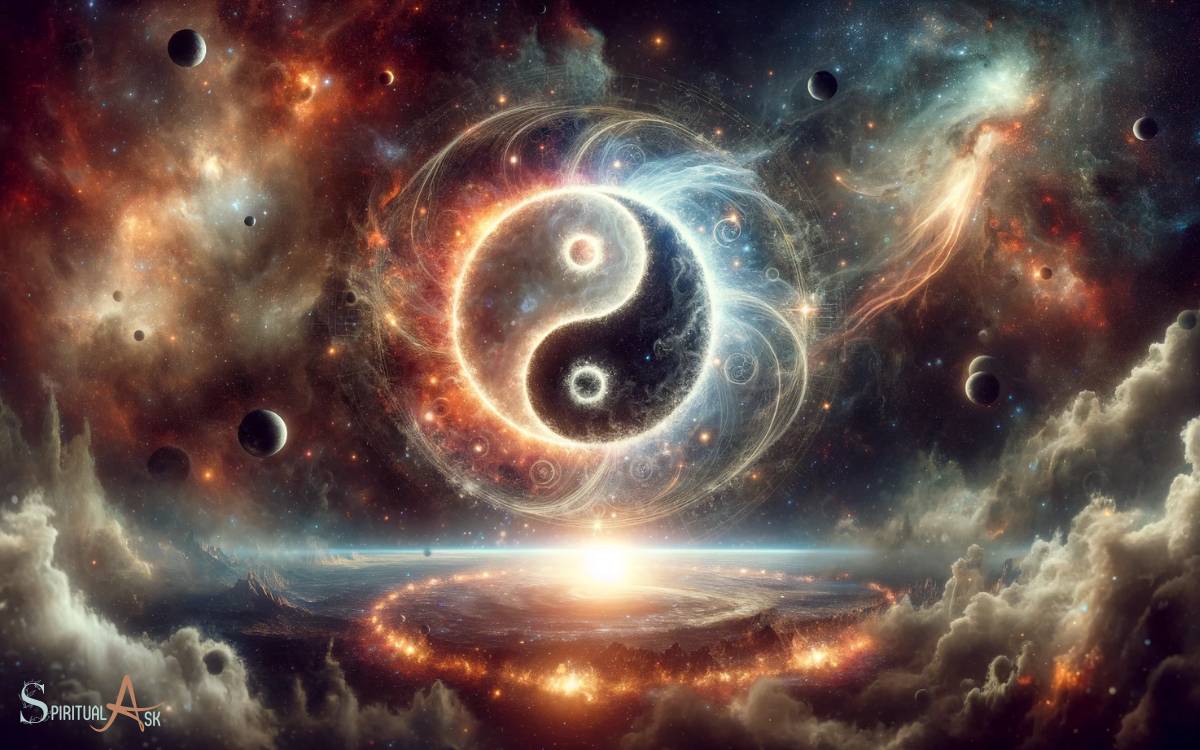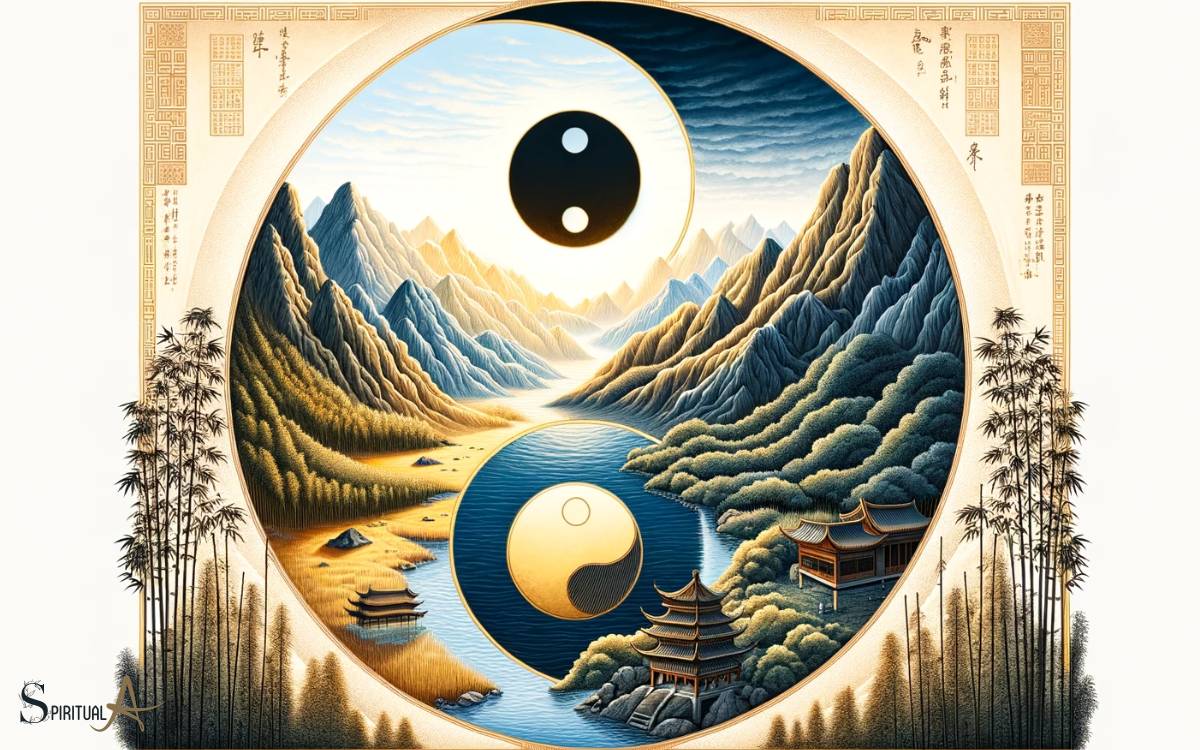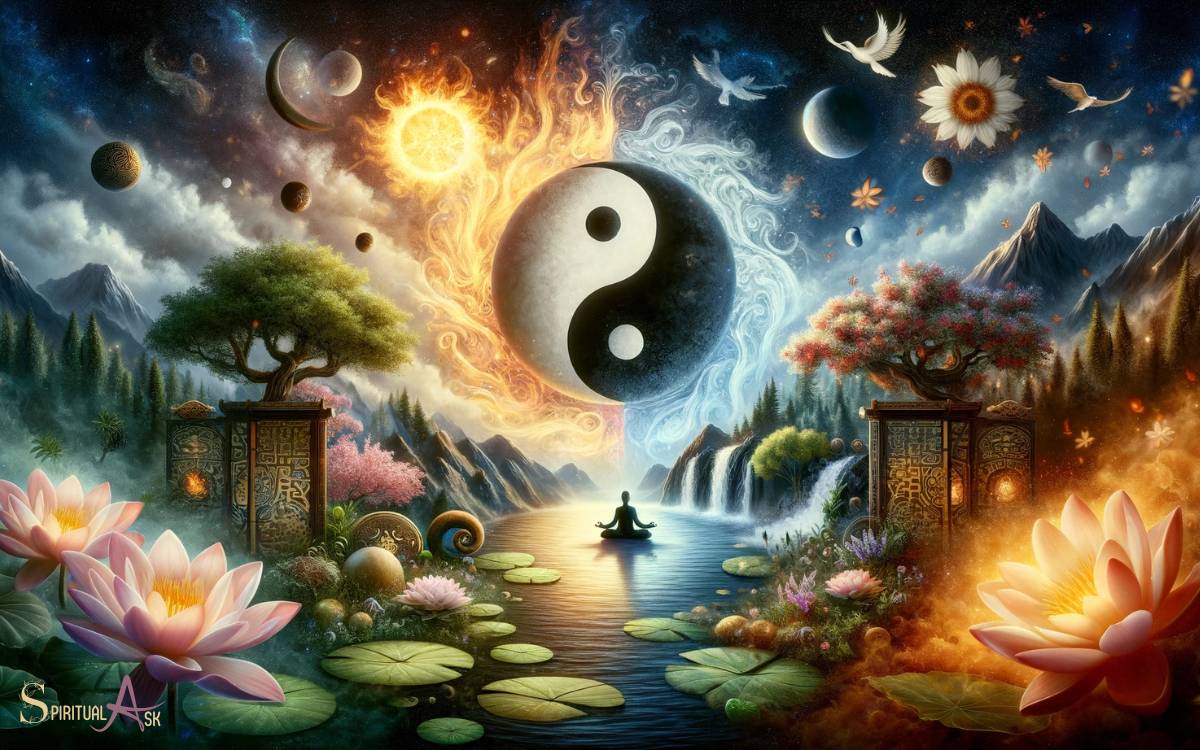Spiritual Meaning of Yin Yang Symbol: Balance And Harmony!
The Yin Yang symbol, rooted in Chinese philosophy, epitomizes the concept of dualism, representing how seemingly opposite forces are interconnected and interdependent in the natural world.
It illustrates balance and harmony, where yin (often associated with darkness, femininity, and passivity) complements yang (light, masculinity, and activity), suggesting that one cannot exist without the other.
The Yin Yang is more than just a symbol; it’s a profound representation of balance and interdependence.
It reminds us that:
For instance, day turns into night, and during winter, seeds lay dormant in preparation for the life that springs forth in the summer all natural cycles encompassed by yin and yang philosophy.
Embrace the wisdom of the Yin Yang symbol, a timeless reminder that in the dance of life’s contrasts, harmony is not only possible but essential.

Key Takeaway
Origins of the Yin Yang Symbol
When exploring the origins of the Yin Yang symbol, it becomes apparent that its history is deeply rooted in ancient Chinese philosophy and cosmology.

The concept of Yin and Yang originated from the idea that everything in the universe consists of two opposing yet complementary forces.
The concept can be traced back to the ancient Chinese text, the I Ching, also known as the Book of Changes, which dates back to around 1000 BCE.
This symbol represents the balance and harmony between two opposing forces, such as light and dark, masculine and feminine, and action and inaction. It signifies the interconnectedness and interdependence of these forces in the natural world and in human existence. When this symbol is depicted upside-down, it takes on a different meaning. The upside-down y symbol meaning can represent imbalance, discord, and disharmony between these opposing forces. It can also signify a disruption of the natural order and a lack of cohesion in the world around us. Whether upright or inverted, this symbol serves as a reminder of the delicate equilibrium that exists in all aspects of life.
Understanding the origins of the Yin Yang symbol provides insight into its profound philosophical significance and enduring relevance in Chinese culture and beyond. This deep-rooted history lays the foundation for comprehending the symbolism of the Yin Yang.
Symbolism of the Yin Yang

In my understanding, the Yin Yang symbol symbolizes the interconnectedness and balance between opposing forces in the universe.
The black and white halves represent the dual nature of existence, such as light and dark, masculine and feminine, and positive and negative energies.
The circle that encloses them signifies the mutual dependence and harmony between these opposing forces. It’s a reminder that one cannot exist without the other, and that within each force lies the seed of the other.
This concept reflects the natural cycles of life, where everything transforms into its opposite over time. The symbol teaches us to embrace the ebb and flow of life, to find balance and harmony in the midst of opposing forces, and to recognize that unity can be found in diversity.
Interpreting the Yin Yang in Taoism
Continuing to explore the symbolism of the Yin Yang, I find Taoism offers a profound perspective on its significance. In Taoism, the Yin Yang represents the dual nature of existence, emphasizing the interconnectedness and interdependence of seemingly opposite forces.

This philosophy encourages us to embrace the harmony and balance between these forces, recognizing that one cannot exist without the other.
In Taoism, the Yin Yang symbolizes:
- The cyclical nature of life, reminding us that change is constant.
- The importance of finding equilibrium and harmony within ourselves and the world around us.
- The idea that opposing forces are complementary, not in conflict.
Understanding the Yin Yang from a Taoist perspective invites us to contemplate the interconnectedness of all things and the balance required for a harmonious existence. This understanding serves as a foundation for its interpretation in Chinese philosophy.
Yin Yang in Chinese Philosophy
Exploring the significance of the Yin Yang in Chinese philosophy reveals its deep-rooted influence on various aspects of life and thought.

In Chinese philosophy, the concept of Yin Yang is central to understanding the natural order of the universe. It represents the duality and interconnectedness of seemingly opposite forces such as light and dark, hot and cold, and life and death.
This philosophy emphasizes the harmony and balance between these forces, suggesting that they are interdependent and complementary rather than conflicting.
Chinese philosophers, such as Confucius and Laozi, incorporated the Yin Yang into their teachings, using it as a framework for ethical behavior, social order, and governance.
Additionally, traditional Chinese medicine and martial arts also draw upon the principles of Yin Yang for holistic healing and balance. This profound philosophical concept continues to shape Chinese culture and thought to this day.
Yin Yang and Balance in Nature

Balancing natural forces, the Yin Yang symbolizes the interconnectedness and harmony of opposing elements in the environment.
This ancient concept reflects the delicate equilibrium that exists in nature, reminding us of the following:
- The delicate dance of predator and prey, each essential for the other’s survival.
- The rhythmic ebb and flow of the tides, a testament to the cyclical nature of life.
- The symbiotic relationship between plants and pollinators, demonstrating the interconnected web of life.
Understanding the balance inherent in the Yin Yang philosophy encourages us to respect and cherish the natural world. It prompts us to seek harmony in our own lives and to appreciate the intricate interplay of opposing forces that sustains the delicate balance of nature.
Yin Yang and Spiritual Harmony
As I reflect on the spiritual meaning of the yin yang symbol, I am drawn to the concept of balance in dualities. The idea that harmony can be found in opposites and unity can emerge from contradictions is a profound one.

These points will guide us as we explore the spiritual significance of the yin yang symbol in the context of harmony.
Balance in Dualities
I find that achieving balance in dualities, such as the concept of yin and yang, is essential for spiritual harmony. Striving for equilibrium in these opposing forces brings about a sense of inner peace and contentment.
When I embrace the duality of life, I feel a deep connection to the world around me. This connection allows me to navigate life’s complexities with a sense of calm and understanding.
- Embracing the light and dark within myself fosters self-acceptance and growth.
- Balancing work and rest leads to increased productivity and overall well-being.
- Acknowledging joy and sorrow in life brings a deeper appreciation for the human experience.
Harmony in Opposites
When striving for spiritual harmony, it’s crucial to recognize the inherent harmony in opposites, as symbolized by the yin yang.
The yin yang represents the interconnectedness and interdependence of seemingly opposing forces.
In spiritual terms, it teaches us that light and dark, good and bad, feminine and masculine are not separate or opposing, but rather interconnected and complementary. This understanding encourages us to embrace the balance and harmony in all aspects of life.
It reminds us that one cannot exist without the other, and true harmony comes from accepting and integrating these opposing forces.
By acknowledging the necessity of both sides, we can strive for a more profound spiritual harmony within ourselves and the world around us.
The yin yang serves as a powerful reminder of the beauty and necessity of opposites working together in harmony.
Unity in Contradictions
Understanding the unity in contradictions represented by the yin yang symbol is essential for achieving spiritual harmony.
The concept of unity in contradictions teaches us that opposing forces are interconnected and interdependent, creating a harmonious whole. This understanding can bring inner peace and a sense of balance to our lives.
- Embracing both light and darkness allows us to find balance within ourselves.
- Accepting the ebb and flow of life’s cycles brings tranquility and resilience.
- Recognizing the interconnectedness of all things fosters a sense of compassion and empathy.
Applying Yin Yang Principles in Life
Embracing the concept of balance and harmony, I integrate the principles of yin and yang into my daily life.

For me, this means striving for a balance between work and rest, action and reflection, and giving and receiving. It’s about recognizing that both yin and yang aspects exist within me and in the world around me.
I seek to embrace the fluidity of these energies, understanding that they are constantly in flux and that finding harmony doesn’t mean achieving a static state, but rather flowing with the natural rhythms of life.
Whether it’s in my relationships, my work, or my personal growth, I aim to embody the complementary nature of yin and yang, allowing their interplay to guide me towards a more balanced and fulfilling existence.
Conclusion
As I reflect on the spiritual meaning of the yin yang symbol, I am reminded of a beautiful sunset I witnessed, where the dark and light perfectly balanced each other in the sky. Just like the yin yang, life is about finding harmony and balance in all things.
Embracing the philosophy of yin yang has helped me navigate through life with a sense of peace and understanding, knowing that everything has its opposite and that finding balance is the key to spiritual harmony.






